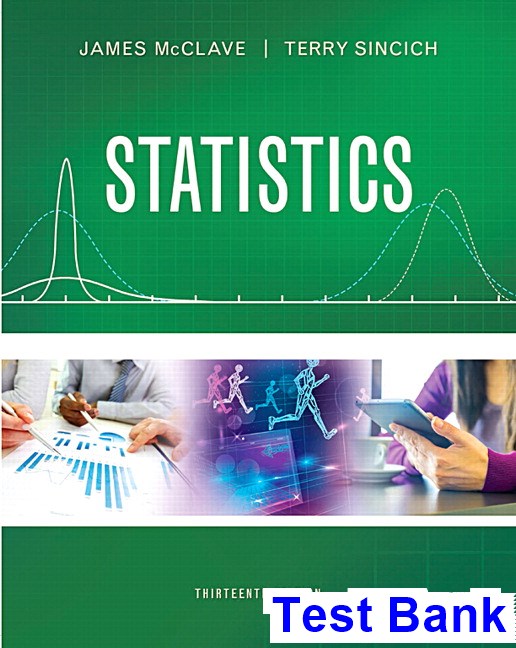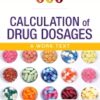Statistics 13th Edition McClave Test Bank
$35.00 Original price was: $35.00.$26.50Current price is: $26.50.
Statistics 13th Edition McClave Test Bank
Instant download Statistics 13th Edition McClave Test Bank pdf docx epub after payment.

Product details:
- ISBN-10 : 0134080211
- ISBN-13 : 978-0134080215
- Author: Dr. Jim McClave; Dr. Terry Sincich
A Contemporary Classic
Classic, yet contemporary; theoretical, yet applied–McClave & Sincich’s Statistics gives you the best of both worlds. This text offers a trusted, comprehensive introduction to statistics that emphasizes inference and integrates real data throughout. The authors stress the development of statistical thinking, the assessment of credibility, and value of the inferences made from data. This new edition is extensively revised with an eye on clearer, more concise language throughout the text and in the exercises.
Ideal for one- or two-semester courses in introductory statistics, this text assumes a mathematical background of basic algebra. Flexibility is built in for instructors who teach a more advanced course, with optional footnotes about calculus and the underlying theory.
Table Of Contents:
- Chapter 1 Statistics, Data, and Statistical Thinking
- 1.1 The Science of Statistics
- 1.2 Types of Statistical Applications
- 1.3 Fundamental Elements of Statistics
- 1.4 Types of Data
- 1.5 Collecting Data: Sampling and Related Issues
- 1.6 The Role of Statistics in Critical Thinking and Ethics
- Statistics in Action: Social Media Network Usage—Are You Linked In?
- Using Technology: MINITAB: Accessing and Listing Data
- Chapter 2 Methods for Describing Sets of Data
- 2.1 Describing Qualitative Data
- 2.2 Graphical Methods for Describing Quantitative Data
- 2.3 Numerical Measures of Central Tendency
- 2.4 Numerical Measures of Variability
- 2.5 Using the Mean and Standard Deviation to Describe Data
- 2.6 Numerical Measures of Relative Standing
- 2.7 Methods for Detecting Outliers: Box Plots and z-Scores
- 2.8 Graphing Bivariate Relationships (Optional)
- 2.9 Distorting the Truth with Descriptive Statistics
- Statistics in Action: Body Image Dissatisfaction: Real or Imagined?
- Using Technology: MINITAB: Describing Data
- TI-83/TI–84 Plus Graphing Calculator: Describing Data
- Chapter 3 Probability
- 3.1 Events, Sample Spaces, and Probability
- 3.2 Unions and Intersections
- 3.3 Complementary Events
- 3.4 The Additive Rule and Mutually Exclusive Events
- 3.5 Conditional Probability
- 3.6 The Multiplicative Rule and Independent Events
- 3.7 Some Additional Counting Rules (Optional)
- Bayes’s Rule (Optional)
- Statistics in Action: Lotto Buster! Can You Improve Your Chance of Winning?
- Using Technology: TI-83/TI-84 Plus Graphing Calculator: Combinations and Permutations
- Chapter 4 Discrete Random Variables
- 4.1 Two Types of Random Variables
- 4.2 Probability Distributions for Discrete Random Variables
- 4.3 Expected Values of Discrete Random Variables
- 4.4 The Binomial Random Variable
- 4.5 The Poisson Random Variable (Optional)
- 4.6 The Hypergeometric Random Variable (Optional)
- Statistics in Action: Probability in a Reverse Cocaine Sting: Was Cocaine Really Sold?
- Using Technology: MINITAB: Discrete probabilities
- TI-83/TI-84 Plus Graphing Calculator: Discrete Random Variables and Probabilities
- Chapter 5 Continuous Random Variables
- 5.1 Continuous Probability Distributions
- 5.2 The Uniform Distribution
- 5.3 The Normal Distribution
- 5.4 Descriptive Methods for Assessing Normality
- 5.5 Approximating a Binomial Distribution with a Normal Distribution (Optional)
- 5.6 The Exponential Distribution (Optional)
- Statistics in Action: Super Weapons Development—Is the Hit Ratio Optimized?
- Using Technology: MINITAB: Continuous Random Variable Probabilities and Normal Probability Plots
- TI–83/TI–84 Plus Graphing Calculator: Normal Random Variable and Normal Probability Plots
- Chapter 6 Sampling Distributions
- 6.1 The Concept of a Sampling Distribution
- 6.2 Properties of Sampling Distributions: Unbiasedness and Minimum Variance
- 6.3 The Sampling Distribution of x and the Central Limit Theorem
- 6.4 The Sampling Distribution of the Sample Proportion
- Statistics in Action: The Insomnia Pill: Is It Effective?
- Using Technology: MINITAB: Simulating a Sampling Distribution
- Chapter 7 Inferences Based on a Single Sample: Estimation with Confidence Intervals
- 7.1 Identifying and Estimating the Target Parameter
- 7.2 Confidence Interval for a Population Mean: Normal (z) Statistic
- 7.3 Confidence Interval for a Population Mean: Student’s t-Statistic
- 7.4 Large-Sample Confidence Interval for a Population Proportion
- 7.5 Determining the Sample Size
- 7.6 Confidence Interval for a Population Variance (Optional)
- Statistics in Action: Medicare Fraud Investigations
- Using Technology: MINITAB: Confidence Intervals
- TI-83/TI-84 Plus Graphing Calculator: Confidence Intervals
- Chapter 8 Inferences Based on a Single Sample: Tests of Hypothesis
- 8.1 The Elements of a Test of Hypothesis
- 8.2 Formulating Hypotheses and Setting Up the Rejection Region
- 8.3 Observed Significance Levels:p-Values
- 8.4 Test of Hypothesis about a Population Mean: Normal (z) Statistic
- 8.5 Test of Hypothesis about a Population Mean: Student’s t-Statistic
- 8.6 Large-Sample Test of Hypothesis about a Population Proportion
- 8.7 Calculating Type II Error Probabilities: More about β (Optional)
- 8.8 Test of Hypothesis about a Population Variance (Optional)
…
People also search:
statistics 13th edition answers
elementary statistics 13th edition answers pdf
|
elementary statistics 13th edition mystatlab access code
|
statistics 13th edition solutions
Related products
Test Bank
Test Bank for Clinical Immunology and Serology A Laboratory Perspective, 3rd Edition: Stevens











